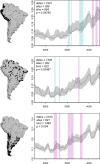Widespread population decline in South America correlates with mid-Holocene climate change
- PMID: 31073131
- PMCID: PMC6509208
- DOI: 10.1038/s41598-019-43086-w
Widespread population decline in South America correlates with mid-Holocene climate change
Abstract
Quantifying the impacts of climate change on prehistoric demography is crucial for understanding the adaptive pathways taken by human populations. Archaeologists across South America have pointed to patterns of regional abandonment during the Middle Holocene (8200 to 4200 cal BP) as evidence of sensitivity to shifts in hydroclimate over this period. We develop a unified approach to investigate demography and climate in South America and aim to clarify the extent to which evidence of local anthropic responses can be generalised to large-scale trends. We achieve this by integrating archaeological radiocarbon data and palaeoclimatic time series to show that population decline occurred coeval with the transition to the initial mid-Holocene across South America. Through the analysis of radiocarbon dates with Monte Carlo methods, we find multiple, sustained phases of downturn associated to periods of high climatic variability. A likely driver of the duration and severity of demographic turnover is the frequency of exceptional climatic events, rather than the absolute magnitude of change. Unpredictable levels of tropical precipitation had sustained negative impacts on pre-Columbian populations lasting until at least 6000 cal BP, after which recovery is evident. Our results support the inference that a demographic regime shift in the second half of the Middle Holocene were coeval with cultural practices surrounding Neotropical plant management and early cultivation, possibly acting as buffers when the wild resource base was in flux.
Conflict of interest statement
The authors declare no competing interests.
Figures




References
-
- Brenner, M. et al. Abrupt climate change and pre-Columbian cultural collapse. In: Markgraf, V. (ed.), Interhemispheric climate linkages 87–103 (2001).
-
- Meltzer, D. J. First Peoples in a New World: Colonizing Ice Age America. Berkeley: University of California Press (2009).
-
- Moore, J. D. A Prehistory of South America. Boulder: University Press of Colorado (2014).
Publication types
MeSH terms
Substances
LinkOut - more resources
Full Text Sources
Medical

